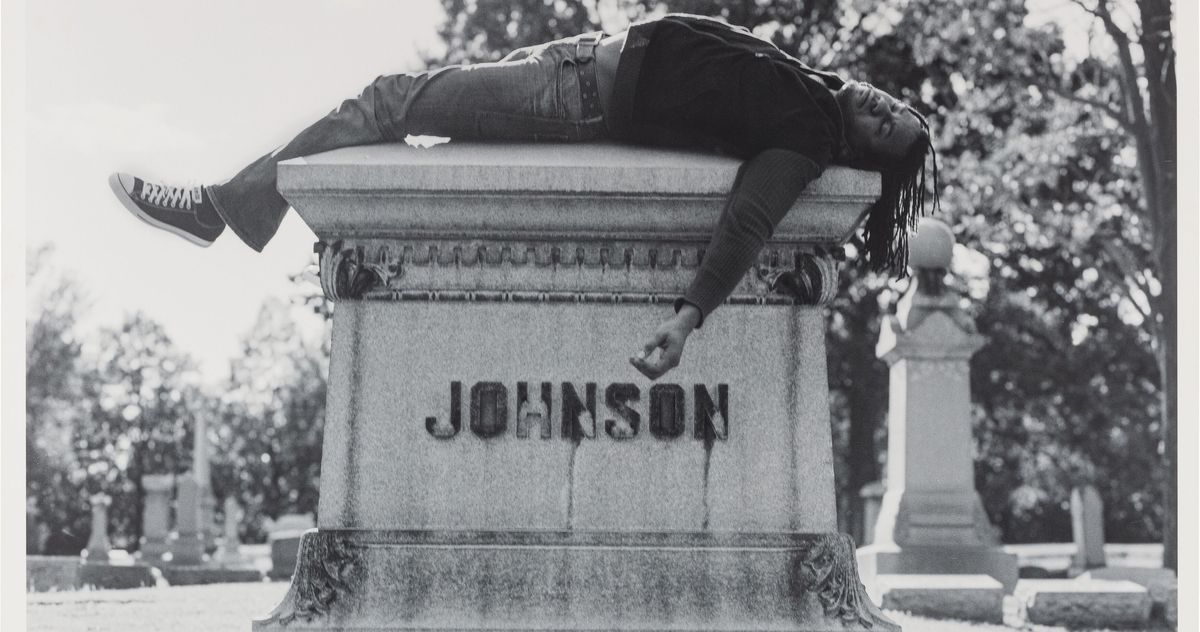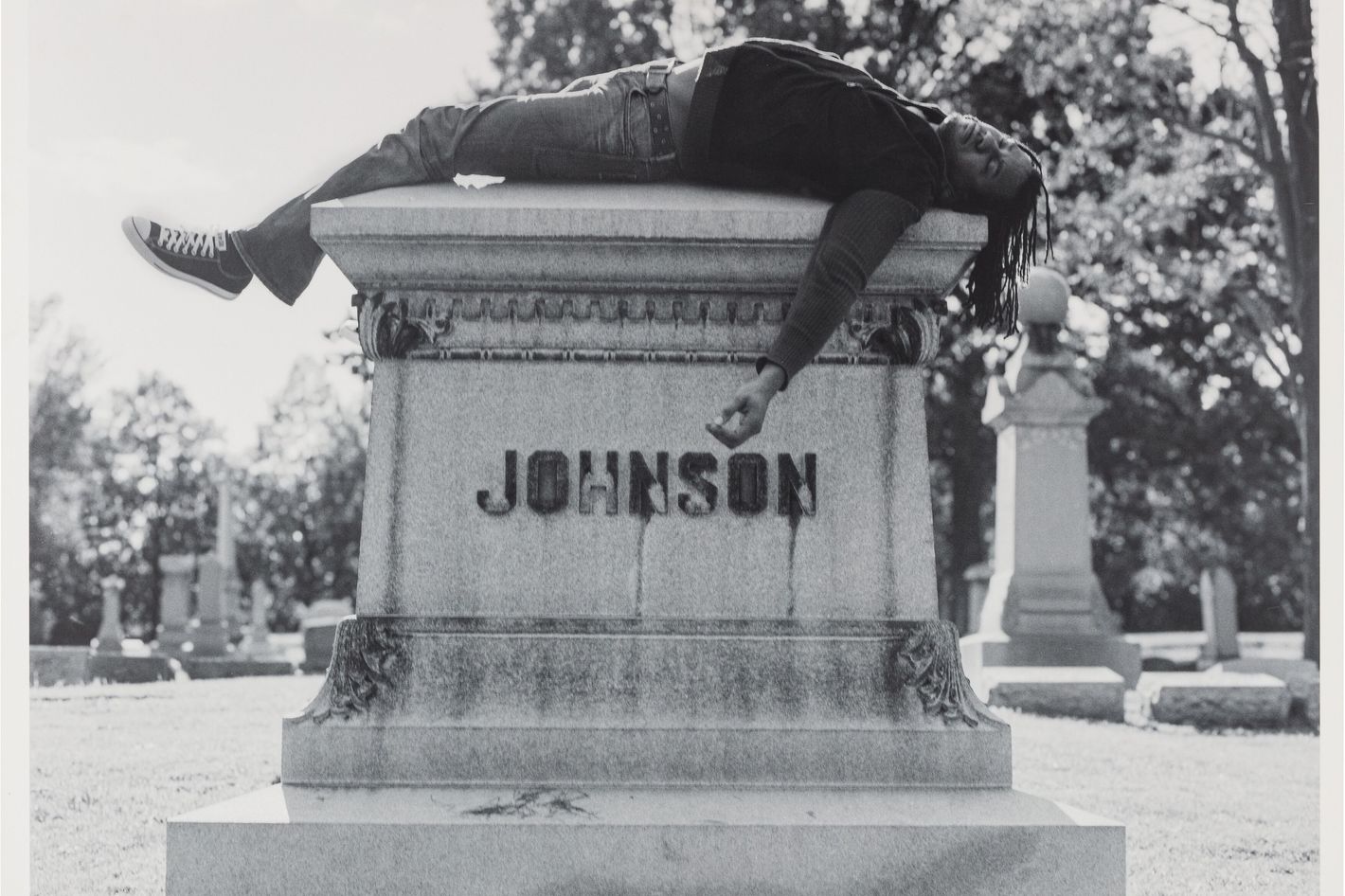Rashid Johnson’s Visual Feast
The new Rashid Johnson survey at the Guggenheim is sprawling and stunning.


Maybe it’s a coincidence that the great American boxer Jack Johnson and the contemporary artist Rashid Johnson share a last name. Jack, the first Black world heavyweight champion who is considered one of the most important boxers of all time, was active during the Jim Crow era, upsetting white supremacists with his success and his marriages to white women. With intention, Rashid Johnson visited the boxer’s grave in 2006 and photographed himself slumped upon its tombstone. In the image, the artist’s posture is that of collapse. His hair pours off his head as if leaking from his skull. Even the name JOHNSON inscribed into the stone seems to be dripping, as if the tomb itself were bleeding. This is the image that opens “Rashid Johnson: A Poem for Deep Thinkers,” a landmark exhibition of over 90 of his works, ongoing at the Guggenheim Museum.
Named after a poem by Amiri Baraka, the show is a visual feast due to Johnson’s multidisciplinary practice. Everything is present: film, photography, sculpture, installation, painting, performance, and conceptual work. The breadth of materials is wide and stunning; ceramic, glass, steel, acrylic, wax, bronze, wood, linen, and more come together in a collection spanning about three decades. Because the survey is so large, it is easy to forget Johnson is only 48 — a midlife and mid-career artist.
Subverting the Guggenheim’s spiral can be hard since it suggests an inherent sense of chronology, but the show’s curators — Guggenheim deputy director and chief curator Naomi Beckwith; interim director and chief curator of the Modern Art Museum of Fort Worth, Texas, Andrea Karnes; and Faith Hunter, a Guggenheim curatorial assistant — dance through the artist’s career without adherence to linearity. Their canny decisions allow visitors to enjoy unexpected pairings such as Fire Pit ‘High Life,’ a bronze-cast boat from 2022, and Death Is Golden, a spray-painted paper from 2004, in the same room.
Central to the show is Johnson’s exploration of the contemporary Black self, questioning how that self participates and is implicated in a continuously evolving history. In some of his early self-portraits — he started out with photography after graduating from the School of the Art Institute of Chicago — he photographs himself after the fashion of famous Black historical figures as part of his “The New Negro Escapist Social and Athletic Club” series. This set of images is a potpourri of visual and historical cues. In The New Negro Escapist Social and Athletic Club (Emmett), from 2008, Johnson references an Associated Press photograph of Emmett Till, who was famously lynched in 1955. In the photo, the boy’s face seems to be divided in two by a shadow running across it, such that one eye is bathed in light and the other in darkness. Although Till was murdered and mutilated in Mississippi, he was born in Chicago, like Johnson. The artist’s approach to the duality in Till’s image is to reproduce himself with an original and a mirror image side by side. But Johnson’s hair is styled in the form of the iconic Frederick Douglass daguerreotype, a subtle reference to the many histories that have colluded and culminated in the production of the slain child.
Johnson’s interests in the Black self naturally lead him toward ties that bind or threaten to separate his community. Working through cultural and intellectual moments — such as Debra Dickerson’s book The End of Blackness in a three-minute video in which Johnson watches a woman read, or through other books (like Neil deGrasse Tyson’s Death by Black Hole and Gwendolyn Brooks’s In the Mecca) that punctuate some of the installations — he creates a map of the Black intelligentsia.
The inclusion of an installation from Johnson’s “Broken Men” series, made in homage to the Nigerian novelist Chinua Achebe, is instructive, suggesting the artist’s ideas of blackness transcend the U.S. and are more diasporic in form. The 2004 piece, titled Homage to Chinua Achebe IV (Fela Kuti “Zombie”), features two sleds coated in white placed side by side. One is damaged, the other intact. The first was dropped from a height, commemorating a 1977 incident in Lagos, Nigeria, when the military government threw Funmilayo Ransome Kuti, a Nigerian hero of independence and women’s rights (and the mother of singer Fela Kuti), out a second-story window.
Because of all the associations in his work, Johnson runs the risk of being unclear. Even though his decisions are carefully constructed, the questions arise, What does the artist himself think? What does he feel?
Me, Tavis Smiley and Shea Butter, a two-minute video from 2004, begins to set up some answers. Johnson is shown on a toilet seat, presumably after a shower, rubbing copious amounts of shea butter onto his skin while the voice of American talk-show host Smiley plays in the background. It is the first time we see shea butter in the show, a substance that features prominently later on. Among many African communities, a common practice is to care for one’s skin with this butter or with powders like camwood and indigo. Apart from beautification and preservation, such extracts are used for their healing abilities. Watching the artist participate in this age-old ritual among Africans (and, later, African Americans) is a profound opening of a curtain onto an intimate conversation among Black people worldwide.
Beyond bodily experiences, and equally as profound, is Sanguine, a large-scale performance installation at the top level of the museum featuring plants that conjoin into a hanging garden; a piano is hidden among the greenery, and a large painting nestles at its core. Titled God Painting “The Spirit,” this 2023 painting is one of the show’s more recent works and announces where the artist’s thought currently is (toward the heavens like the eponymous Baraka poem), while holding a promise for what is possible in his future. Painted on a rich reddish background the color of clay or mud bricks, 11 oval outlines in the shape of cocoa pods are arranged in seven rows. Some are filled in with another shade of brownish red with faint scratches that give the work the appearance of sentience. It is a joy to stumble onto this painting, right there at the center of the foliage, as though a galactic presence suddenly appeared on the earth, the way the biblical Moses must have felt encountering the burning bush.
A wrong question one might ask because Johnson’s work uses many voices is “Exactly which voice belongs to the artist?” But if this question were to persist, “A Poem for Deep Thinkers” provides answers. Thankfully, the show makes clear that Johnson’s voice is a single one speaking many languages, and the answers do not require the artist to divorce himself from his community. Johnson’s art is a reminder that one voice can translate a single world in multiple ways.








